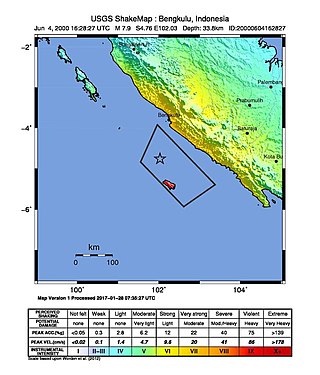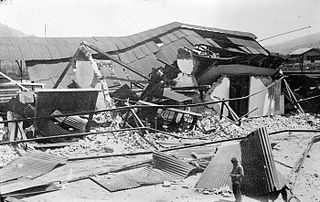
The 2005 Nias–Simeulue earthquake occurred on 28 March off the west coast of northern Sumatra, Indonesia in the subduction zone of the Sunda megathrust. At least 915 people were killed, mostly on the island of Nias. It was among the top 10 most powerful recorded worldwide since 1900, with a magnitude of 8.6 that caused a relatively small tsunami. Damage ranged from hundreds of buildings destroyed in Nias to widespread power outages throughout the island of Sumatra. Following the mainshock, eight major aftershocks occurred ranging from 5.5 to 6.0 magnitudes.

At 23:28 local time on June 4, 2000, southern Sumatra, Indonesia was struck by an earthquake of moment magnitude 7.9 with a maximum Mercalli intensity of VI (Strong). The event occurred off the coast near Enggano Island. There were more than 100 fatalities and up to 2,585 injuries. Over 730 aftershocks shook the area afterwards, one just eleven minutes after the mainshock.

The 1833 Sumatra earthquake occurred on November 25 at about 22:00 local time, with an estimated magnitude in the range of 8.8–9.2 Mw . It caused a large tsunami that flooded the southwestern coast of the island. There are no reliable records of the loss of life, with the casualties being described only as 'numerous'. The magnitude of this event has been estimated using records of uplift taken from coral microatolls.

The Sunda megathrust is a fault that extends approximately 5,500 km (3300 mi) from Myanmar (Burma) in the north, running along the southwestern side of Sumatra, to the south of Java and Bali before terminating near Australia. It is a megathrust, located at a convergent plate boundary where it forms the interface between the overriding Eurasian plate and the subducting Indo-Australian plate. It is one of the most seismogenic structures on Earth, being responsible for many great and giant earthquakes, including the 2004 Indian Ocean earthquake and tsunami that killed over 227,000 people. The Sunda megathrust can be divided into the Andaman Megathrust, Sumatra(n) Megathrust and Java(n) Megathrust. The Bali-Sumbawa segment is much less active and therefore does not have the "megathrust" term associated with it.
The 1797 Sumatra earthquake occurred at 22:00 local time on 10 February. It was the first in a series of great earthquakes that ruptured part of the Sumatran segment of the Sunda megathrust. It caused a damaging tsunami that was particularly severe near Padang, where a 150–200 t English ship was driven 1 km (0.62 mi) inland up the Arau River.
The 1984 Northern Sumatra earthquake occurred with a moment magnitude of 7.2 on November 17 at 06:49 UTC. The epicentre was located off the coast of Sumatra, near the island of Nias, where building damage was reported. This earthquake could be strongly felt in parts of Northern Sumatra, including Padang and Medan. The focal mechanism corresponded to reverse faulting.
The 1935 Sumatra earthquake occurred at on 28 December. It had a magnitude of 7.7 and a maximum felt intensity of VII (Damaging) on the European macroseismic scale. It triggered a minor tsunami.

The 1943 Alahan Panjang earthquakes occurred on June 8 and June 9 UTC in Sumatra, then under Japanese occupation. This was an earthquake doublet.
The 2012 Indian Ocean earthquakes were magnitude 8.6 and 8.2 Mw undersea earthquakes that struck near the Indonesian province of Aceh on 11 April at 15:38 local time. Initially, authorities feared that the initial earthquake would cause a tsunami and warnings were issued across the Indian Ocean; however, these warnings were subsequently cancelled. These were unusually strong intraplate earthquakes and the largest strike-slip earthquake ever recorded.
On 2 July 2013, an earthquake struck the Indonesian island of Sumatra on 2 July with a moment magnitude of 6.1 and a maximum Mercalli intensity of VI (Strong). The strike-slip earthquake killed at least 43 people and injured more than 2,500 others in the province of Aceh where approximately 4,300 homes were damaged or destroyed.
The Sumatra Trench is a part of the Sunda Trench or Java Trench. The Sunda subduction zone is located in the east part of Indian Ocean, and is about 300 km (190 mi) from the southwest coast of Sumatra and Java islands. It extends over 5,000 km (3,100 mi) long, starting from Myanmar in the northwest and ending at Sumba Island in the southeast.

On February 20, 2008, an earthquake with a moment magnitude of 7.4 struck off the coast of Sumatra at a hypocentre depth of 26 km. The earthquake had an epicenter located on the island of Simeulue, northwest from Sinabang, a small town on the island. Three people were killed and an additional 25 seriously injured as a result of the earthquake.

West Sumatra, Dutch East Indies was struck by an earthquake doublet on June 28, 1926. The first earthquake occurred at 10:23 local time, with an estimated magnitude of 6.7 on the surface-wave magnitude scale with an intensity of IX (Violent) on the Modified Mercalli Intensity Scale. Less than three hours later, a second earthquake occurred with a magnitude of 6.4 Ms although it appears to have been less damaging. Three hundred and fifty-four people were killed during the first earthquake, with later shocks killing a total of 57 according to local records.

An earthquake occurred 112 km, offshore, north of Maumere in the Flores Sea on 14 December. The quake had a moment magnitude of 7.3 according to the United States Geological Survey (USGS). One person was killed and 173 others suffered injuries.
The 1843 Nias earthquake off the northern coast of Sumatra, Indonesia caused severe damage when it triggered a tsunami along the coastline. The earthquake with a moment magnitude (Mw ) of 7.8 lasted nine minutes, collapsing many homes in Sumatra and Nias. It was assigned a maximum modified Mercalli intensity of XI (Extreme).

On 25 February 2022 at 08:39 WIB, a moment magnitude (Mw ) 6.2 earthquake struck West Sumatra, Indonesia at a depth of 4.0 km (2.5 mi). Preceded by one foreshock and followed by over 200 aftershocks, the mainshock had an epicenter at the foot of Mount Talakmau in Pasaman Regency. The mainshock was the result of strike-slip faulting along a previously unidentified segment of the Great Sumatran Fault. At least 27 people died, 457 were injured, and 19,221 others were displaced. It inflicted 780 million Indonesian rupiahs (Rp) worth of damage. The heaviest damage was recorded at three villages around Mount Talakmau. Landslides and flash floods caused additional damage and casualties.
The 1933 Sumatra earthquake or Liwa earthquake occurred in West Lampung Regency, Lampung Province, Indonesia on June 25. The earthquake had an estimated surface-wave magnitude (Ms ) of 7.7 occurring at a shallow depth of 20 km. It had an epicenter onshore, devastating the city of Liwa. At least 788 people were reported killed, although the death toll may have been in the thousands. Aftershocks followed, including one which was strong enough to cause additional fatalities. The mainshock also triggered a nearby volcanic eruption two weeks later, killing some people.
The February 2004 Nabire earthquakes began on February 6 at 06.05 WIT in Nabire Regency, Central Papua, Indonesia. The first of three large earthquakes measured 7.0 on the moment magnitude scale (Mw ). It was followed a few days later by two strong shocks, measuring Mw 7.3 and 6.7, respectively. The earthquakes were felt at Nabire with a maximum Mercalli intensity of VI (Strong). At least 37 people were killed and were 682 injured, and over 2,600 buildings were damaged or destroyed.
The 1909 Kerinci earthquake struck Sumatra, Dutch East Indies on June 4 at 01:40 WIB. The shock measured 7.6 and occurred along the Great Sumatran fault. Damage was extensive and great around the Kerinci area; many homes collapsed and roads were damaged. The death toll stood at between 195 and 230.
On 18 September 2024, at 09:41:06 WIB, a 5.0 earthquake struck Bandung Regency in West Java, Indonesia, 14 km (8.7 mi) east-southeast of Banjar.









